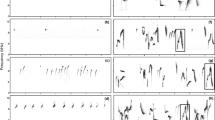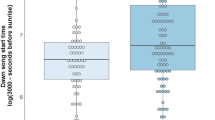Abstract
In many songbirds, individuals have repertoires of multiple song types, some of which may be shared with others in the local area. Hypotheses about the evolution of song repertoires differ as to whether selection acts primarily on repertoire size itself or the ability to match songs of neighbours. We used a 16-channel acoustic location system to record neighbourhoods of song sparrows (Melospiza melodia melodia) during the dawn chorus. We asked whether males sing all songs with similar frequency as predicted by the Repertoire Size Hypothesis, whether males preferentially sing highly shared songs as predicted by the General Sharing Hypothesis, or whether use of highly shared songs is associated with phenotype as predicted by the Conditional Sharing Hypothesis. Contrary to the Repertoire Size Hypothesis, most males did not sing all songs equally often. Contrary to the General Sharing Hypothesis, we found no general tendency to overproduce highly shared songs. The degree to which males overproduced highly shared songs was repeatable across days, indicating consistent individual differences, and varied across neighbourhoods. Moreover, and consistent with the Conditional Sharing Hypothesis, older males were more likely to overproduce highly shared songs. If highly shared song is a conventional signal of aggression, with the threat of receiver retaliation maintaining honesty, older males may be more willing or able to risk conflict. Alternatively, males may learn which songs are effective signals for an area. Finally, age-related variation in vocal performance may shape the adaptive value of highly shared song.




Similar content being viewed by others
References
Anderson R (2009) Operant conditioning and copulation solicitation display assays reveal a stable preference for local song by female swamp sparrows Melospiza georgiana. Behav Ecol Sociobiol 64:215–223
Anderson RC, Searcy WA, Nowicki S (2005) Partial song matching in an eastern population of song sparrows, Melospiza melodia. Anim Behav 69:189–196
Anderson RC, Searcy WA, Nowicki S (2008) Testing the function of song-matching in birds: responses of eastern male song sparrows Melospiza melodia to partial song-matching. Behaviour 145:347–363
Arcese P (1987) Age, intrusion pressure and defense against floaters by territorial male song sparrows. Anim Behav 35:773–784
Baker MC, Spitler-Nabors KJ, Bradley DC (1981) Early experience determines song dialect responsiveness of female sparrows. Science 214:819–821
Baker MC, Bjerke T, Lampe H, Espmark Y (1986) Sexual response of female great tits to variation in size of males’ song repertoires. Am Nat 128:491–498
Ballentine B (2009) The ability to perform challenging songs predicts age and size in male swamp sparrows (Melospiza georgiana). Anim Behav 77:973–978
Beecher MD (2008) Function and mechanisms of song learning in song sparrows. Adv Study Behav 38:167–225
Beecher MD, Brenowitz EA (2005) Functional aspects of song learning in songbirds. Trends Ecol Evol 30:143–149
Beecher MD, Campbell SE, Nordby JC (2000) Territory tenure in song sparrows is related to song sharing with neighbours, but not to repertoire size. Anim Behav 59:29–37
Blumstein DT, Mennill DJ, Clemins P, Girod L, Yao K, Patricelli G, Deppe JL, Krakauer AH, Clark C, Cortopassi KA, Hanser SF, McCowan B, Ali AM, Kirscehl ANG (2011) Acoustic monitoring in terrestrial environments using microphone arrays: applications, technological considerations, and prospectus. J Appl Ecol 48:758–767
Briefer E, Aubin T, Lehongre K, Rybak F (2008) How to identify dear enemies: the group signature in the complex song of the skylark Alauda arvensis. J Exp Biol 211:317–326
Buchanan KL, Catchpole CK (1997) Female choice in the sedge warbler Acrocephalus schoenobaenus: multiple cues from song and territory quality. Proc R Soc Lond B 264:521–526
Burt JM, Vehrencamp SL (2005) Dawn chorus as an interactive communication network. In: McGregor PK (ed) Animal communication networks. Cambridge University, Cambridge, pp 320–343
Burt JM, Campbell SE, Beecher MD (2001) Song type matching as a threat: a test using interactive playback. Anim Behav 62:1163–1170
Catchpole CK (1980) Sexual selection and the evolution of complex songs among European warblers of the genus Acrocephalus. Behaviour 74:149–166
Catchpole CK, Dittami J, Leisler B (1984) Differential responses to male song repertoires in female songbirds implanted with oestradiol. Nature 312:563–564
Chatterjee SH, Hadi AS, Price B (2000) Regression analysis by example. Wiley, New York
Clutton-Brock TH (1984) Reproductive effort and terminal investment in iteroparous animals. Am Nat 123:212–229
Foote JR, Barber CA (2007) High level of song sharing found in an eastern population of song sparrows (Melospiza melodia). Auk 124:53–62
Gentner TQ, Hulse SH (2000) Female European starling preference and choice for variation in conspecific male song. Anim Behav 59:443–458
Gutzwiller KJ, Wiedenmann RT, Clements KL, Anderson SH (1994) Effects of human intrusion on song occurrence and singing consistency in subalpine birds. Auk 111:28–37
Hasselquist D, Bensch S, von Schantz T (1996) Correlation between male song repertoire, extra-pair paternity and offspring survival in the great reed warbler. Nature 381:229–232
Hill CE, Akçay Ç, Campbell SE, Beecher MD (2011) Extrapair paternity, song, and genetic quality in song sparrows. Behav Ecol 22:73–81
Horning CL, Beecher MD, Stoddard PK, Campbell SE (1993) Song perception in the song sparrow: importance of different parts of the song in song type classification. Ethology 94:46–58
Hughes M, Nowicki S, Searcy WA, Peters S (1998) Song type sharing in song sparrows: implications for repertoire function and song learning. Behav Ecol Sociobiol 42:437–446
Hughes M, Anderson RC, Searcy WA, Bottensek LM, Nowicki S (2007) Song type sharing and territory tenure in eastern song sparrows: implications for the evolution of song repertoires. Anim Behav 73:701–710
Hyman J, Hughes M, Searcy WA, Nowicki S (2004) Individual variation in the strength of territory defense in song sparrows: correlates of age, territory tenure, and neighbour aggressiveness. Behaviour 141:15–27
Irwin RE (1988) The evolutionary significance of behavioral development: the ontogeny and phylogeny of bird song. Anim Behav 36:814–824
Irwin RE (1990) Directional sexual selection cannot explain variation in song repertoire size in the New World blackbirds (Icterinae). Ethology 85:212–224
Kiefer S, Sommer C, Scharff C, Kipper S (2010) Singing the popular songs? Nightingales share more song types with their breeding population in their second season than in their first. Ethology 116:619–626
Kipper S, Kiefer S (2010) Age-related changes in birds’ singing styles: on fresh tunes and fading voices? Adv Stud Behav 41:77–118
Krebs JR (1977) The significance of song repertoires: the Beau Geste hypothesis. Anim Behav 25:475–478
Krebs JR, Ashcroft R, van Orsdol K (1981) Song matching in the great tit Parus major L. Anim Behav 29:918–923
Lessels CM, Boag PT (1987) Unrepeatable repeatabilities: a common mistake. Auk 104:116–121
Logue DM, Forstmeier W (2008) Constrained performance in a communication network: implications for the function of song-type matching and for the evolution of multiple ornaments. Am Nat 172:34–41
MacDougall-Shackleton EA, Stewart KA, Potvin DA, Tennenhouse E (2009) The rich get richer: song complexity predicts song element sharing and song output in song sparrows Melospiza melodia. Anim Behav 78:141–146
MacDougall-Shackleton SA (1997) Sexual selection and the evolution of song repertoires. Curr Ornithol 14:81–124
Marshall RC, Buchanan KL, Catchpole CK (2007) Song and female choice for extra-pair copulations in the sedge warbler Acrocephalus schoenobaenus. Anim Behav 73:629–635
Maynard Smith J (1982) Evolution and the theory of games. Cambridge University, Cambridge
Mennill DJ (2011) Individual distinctiveness in avian vocalizations and the spatial monitoring of behaviour. Ibis 153:235–238
Mennill DJ, Otter KA (2007) Status signalling and communication networks in black-capped chickadees: complex communication with a simple song. In: Otter K (ed) Ecology and behavior of chickadees and titmice. Oxford University, Oxford, pp 215–233
Mennill DJ, Burt JM, Fristrup KM, Vehrencamp SL (2006) Accuracy of an acoustic location system for monitoring the position of duetting songbirds in tropical forest. J Acoust Soc Am 119:2832–2839
Nelson DA, Marler P (1994) Selection-based learning in bird song development. Proc Natl Acad Sci USA 91:10498–10501
Nielsen BMB, Vehrencamp SL (1995) Responses of song sparrows to song-type matching via interactive playback. Behav Ecol Sociobiol 37:109–117
Nordby JC, Campbell SE, Beecher MD (2002) Adult song sparrows do not alter their song repertoires. Ethology 108:39–50
Nowicki S, Peters S, Podos J (1998) Song learning, early nutrition and sexual selection in songbirds. Am Zool 38:179–190
Nowicki S, Searcy WA, Peters S (2002) Brain development, song learning and mate choice in birds: a review and experimental test of the “nutritional stress hypothesis”. J Comp Physiol A 188:1003–1014
O’Loghlen AL, Beecher MD (1999) Mate, neighbour and stranger songs: a female song sparrow perspective. Anim Behav 58:13–20
O’Loghlen AL, Rothstein SI (1995) Culturally correct song dialects are correlated with male age and female song preferences in wild populations of brown-headed cowbirds. Behav Ecol Sociobiol 36:251–259
Pfaff JA, Zanette L, MacDougall-Shackleton SA, MacDougall-Shackleton EA (2007) Song repertoire size varies with HVC volume and is indicative of male quality in song sparrows (Melospiza melodia). Proc R Soc Lond B 274:2035–2040
Reid JM, Arcese P, Cassidy A, Hiebert SM, Smith JNM, Stoddard PK, Marr AB, Keller LF (2004) Song repertoire size predicts initial mating success in male song sparrows, Melospiza melodia. Anim Behav 68:1055–1063
Reid JM, Arcese P, Cassidy ALEV, Marr AB, Smith JNM, Keller LF (2005) Hamilton and Zuk meet heterozygosity? Song repertoire size indicates inbreeding and immunity in song sparrows (Melospiza melodia). Proc R Soc Lond B 272:481–487
Searcy WA (1984) Song repertoire size and female preferences in song sparrows. Behav Ecol Sociobiol 14:281–286
Searcy WA, Beecher MD (2009) Song as an aggressive signal in songbirds. Anim Behav 78:1281–1292
Searcy WA, Marler P (1981) A test for responsiveness to song structure and programming in female sparrows. Science 213:926–928
Searcy WA, Nowicki S, Hughes M, Peters S (2002) Geographic song discrimination in relation to dispersal distances in song sparrows. Am Nat 159:221–230
Searcy WA, Anderson RC, Nowicki S (2006) Bird song as a signal of aggressive intent. Behav Ecol Sociobiol 60:234–241
Slater PJB (1981) Chaffinch song repertoire: observations, experiments and a discussion of their significance. Z Tierpsychol 56:1–24
Stewart KA, MacDougall-Shackleton EA (2008) Local song elements indicate local genotypes and predict physiological condition in song sparrows Melospiza melodia. Biol Lett 4:240–242
Tracy TT, Baker MC (1999) Geographic variation in syllables of house finch songs. Auk 116:666–676
Vehrencamp SL (2001) Is song-type matching a conventional signal of aggressive intentions? Proc R Soc Lond B 268:1637–1642
Wilson PL, Towner MC, Vehrencamp SL (2000) Survival and song-type sharing in a sedentary subspecies of the song sparrow. Condor 102:355–363
Wingfield JC, Hegner RE, Dufty AM, Ball GF (1987) The “challenge hypothesis”: theoretical implications for patterns of testosterone secretion, mating systems, and breeding strategies. Am Nat 136:829–846
Zar JH (1999) Biostatistical analysis, 4th edn. Prentice-Hall, Upper Saddle River
Acknowledgements
We thank M. Conboy, F. Connor, M. Farquhar, J. Kewin, V. La, D. Potvin, S. Russell, Y. Sarquis Adamson, D. Wilson and L. Wilson for field assistance; S. MacDougall-Shackleton for comments; and the Queen’s University Biological Station as well as the Queen’s Biological Communication Centre for logistical support. Financial support was provided through Natural Sciences and Engineering Research Council of Canada (NSERC) grants to DJM and EAMS; an Ontario Ministry of Research and Innovation Early Researcher Award to EAMS; Canada Foundation for Innovation and Ontario Research Foundation grants to DJM and EAMS; and a University of Western Ontario Graduate Fellowship to JML. All procedures were approved by the Animal Use Subcommittee at the University of Western Ontario (protocol #2008-054).
Conflicts of interest
The authors declare that they have no conflict of interest.
Author information
Authors and Affiliations
Corresponding author
Additional information
Communicated by M. Hughes
Rights and permissions
About this article
Cite this article
Lapierre, J.M., Mennill, D.J. & MacDougall-Shackleton, E.A. Spatial and age-related variation in use of locally common song elements in dawn singing of song sparrows Melospiza melodia: old males sing the hits. Behav Ecol Sociobiol 65, 2149–2160 (2011). https://doi.org/10.1007/s00265-011-1223-1
Received:
Revised:
Accepted:
Published:
Issue Date:
DOI: https://doi.org/10.1007/s00265-011-1223-1




